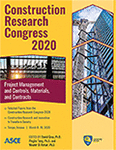Construction Research Congress 2020
Constraints of Modular Construction for Fully Serviced and Finished Homes: Lessons Learned from Canada
Publication: Construction Research Congress 2020: Project Management and Controls, Materials, and Contracts
ABSTRACT
Among different approaches to modular construction, the fully serviced and finished home is the most advanced approach that has revolutionized the construction industry. The benefits of this approach are realized in enhancing the workflow, efficient use of resources, improving construction safety, reducing construction wastes, cutting the on-site contractors, optimizing the construction scheduling, and consequently the project duration. However, more investigations are required to explore the constraints of employing this approach and the possible mitigations to overcome those. The aim of this study is to tackle the constraints of adopting fully serviced and finished homes from a manufacturer’s perspective. To accomplish this objective, a literature review was conducted and the most important constraints found were used for a semi-structured interview with a Canadian manufacturer. The three most important constraints were highlighted and the approached adopted to overcome those limitations by that specific manufacturer are discussed. Furthermore, five themes that were less important to this manufacturer were investigated. This study is an informative asset for the industry practitioners to have a better understanding of the limitations and applicability of modular construction.
Get full access to this article
View all available purchase options and get full access to this chapter.
ACKNOWLEDGMENT
The authors would like to thank Cal Harvey, former chief executive officer and co-founder of LINQS Developments Company, who kindly accepted to be interviewed for this study and Mohsen Hatami, Ph.D. student at Rinker School of Construction Management, for his assistance in editing the manuscript.
REFERENCES
Arashpour, M., Wakefield, R., Abbasi, B., Lee, E. W. M., and Minas, J. (2016). “Off-site construction optimization: Sequencing multiple job classes with time constraints.” Automation in Construction, 71, 262–270.
Arashpour, M., Wakefield, R., Blismas, N., and Minas, J. (2015). “Optimization of process integration and multi-skilled resource utilization in off-site construction.” Automation in Construction, 50, 72–80.
Arif, M., and Egbu, C. (2010). “Making a case for offsite construction in China.” Engineering, Construction and Architectural Management.
Azhar, S., Lukkad, M. Y., and Ahmad, I. (2013). “An Investigation of Critical Factors and Constraints for Selecting Modular Construction over Conventional Stick-Built Technique.” International Journal of Construction Education and Research, 9(3), 203–225.
Carrillo, P. (2005). “Lessons learned practices in the engineering, procurement and construction sector.” Engineering, Construction and Architectural Management.
Chao, M., Qiping, S., Wei, P., and Kunhui, Y. (2015). “Major Barriers to Off-Site Construction: The Developer’s Perspective in China.” Journal of Management in Engineering, 31(3), 04014043.
Corbin, J., and Strauss, A. (2008). Basics of qualitative research: Techniques and procedures for developing grounded theory, 3rd ed. Basics of qualitative research: Techniques and procedures for developing grounded theory, 3rd ed, Sage Publications, Inc, Thousand Oaks, CA, US.
Creswell, J. W., and Poth, C. N. (2017). Qualitative Inquiry and Research Design: Choosing Among Five Approaches. SAGE Publications.
DiCicco-Bloom, B., and Crabtree, B. (2006). “The qualitative research interview.” Medical Education, 40(4), 314–321.
Gibb, A. G. F. (1999). Off-site Fabrication: Prefabrication, Pre-assembly and Modularisation. John Wiley & Sons.
Goodier, C., and Gibb, A. (2007). “Future opportunities for offsite in the UK.” Construction Management and Economics, 25(6), 585–595.
Groat, L. N., and Wang, D. (2002). “Architectural Research Methods.” 480.
Hwang, B.-G., Shan, M., and Looi, K.-Y. (2018). “Key constraints and mitigation strategies for prefabricated prefinished volumetric construction.” Journal of Cleaner Production, 183, 183–193.
Jaillon, L., and Poon, C. S. (2008). “Sustainable construction aspects of using prefabrication in dense urban environment: a Hong Kong case study.” Construction Management and Economics, 26(9), 953–966.
Jaillon, L., and Poon, C.-S. (2010). “Design issues of using prefabrication in Hong Kong building construction.” Construction Management and Economics, 28(10), 1025–1042.
Johnsson, H., and Meiling, J. H. (2009). “Defects in offsite construction: timber module prefabrication.” Construction Management and Economics, 27(7), 667–681.
Kamali, M., and Hewage, K. (2017). “Development of performance criteria for sustainability evaluation of modular versus conventional construction methods.” Journal of Cleaner Production, 142, 3592–3606.
Mao, C., Xie, F., Hou, L., Wu, P., Wang, J., and Wang, X. (2016). “Cost analysis for sustainable off-site construction based on a multiple-case study in China.” Habitat International, 57, 215–222.
Motiar, R. M. (2014). “Barriers of Implementing Modern Methods of Construction.” Journal of Management in Engineering, 30(1), 69–77.
Information & Authors
Information
Published In
Construction Research Congress 2020: Project Management and Controls, Materials, and Contracts
Pages: 1057 - 1063
Editors: David Grau, Ph.D., Arizona State University, Pingbo Tang, Ph.D., Arizona State University, and Mounir El Asmar, Ph.D., Arizona State University
ISBN (Online): 978-0-7844-8288-9
Copyright
© 2020 American Society of Civil Engineers.
History
Published online: Nov 9, 2020
Published in print: Nov 9, 2020
Authors
Metrics & Citations
Metrics
Citations
Download citation
If you have the appropriate software installed, you can download article citation data to the citation manager of your choice. Simply select your manager software from the list below and click Download.
